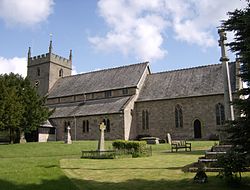Burghill
| Burghill | |
| Herefordshire | |
|---|---|
 St Mary the Virgin Church, Burghill | |
| Location | |
| Grid reference: | SO474449 |
| Location: | 52°5’51"N, 2°45’58"W |
| Data | |
| Population: | 1,579 (2011) |
| Post town: | Hereford |
| Postcode: | HR4 |
| Dialling code: | 01432 |
| Local Government | |
| Council: | Herefordshire |
| Parliamentary constituency: |
North Herefordshire |
Burghill is a village in Herefordshire, north-west of Hereford. The parish includes the villages of Burghill, Tillington, Portway and Eltons Marsh. It was originally a small village of farms and orchards situated on the road from Moreton-on-Lugg.
History
There was originally an iron hill fort in prehistory on the hill north of Hereford. One of the earliest settlements in the shire it stood on a Roman road from Kenchester; it was probably recognised by Alfred the Great's 'burghal hidage'. Burghill is called Burgelle in the Domesday Book, and in Pipe Rolls, 1169, as Burchil. By 1212 the Red Book of Exchequer used the name Burghulle. It has been Burghill for the last eight centuries.[1]
It has been suggested that Burghill may have been the site of the first castle to have been built in England; built before the Norman conquest, about the year 1051, by Normans in the service of Osbern Pentecost, a follower of Ralph the Timid (Ralph de Mantes) whom King Edward the Confessor had brought form Normandy to be Earl of Hereford and defend the lands of Herefordshire..[2][3]
In the Middle Ages, Burghill was a feudal manor with a strip field system of villein cultivation. Its true significance however was as a nobleman's manor owned first by Bernard de Neumarch, William de Braose, and thence to Humphrey de Bohun, Earl of Hereford. It was connected to the manor of Tillington in the 13th century until Roger de Burghill sold it to Earl Berkeley of Berkeley Castle, Gloucestershire.
The manor of Burghill passed through various scions of the de Burghill family until 1303 when the de Mynors share past to Godfrey de Gamage; both families renowned locally. In the early modern period the estate was split up when Griffin Barton bought in part before in 17th century Richard Witherstone built The Lodge.[4]
The Hereford County and City Lunatic Asylum, later known as St Mary's Hospital after the church, was erected in the village in 1868. It closed in the 20th century after use as a psychiatric hospital and was demolished to make way for a housing estate in 1994.
Church
The parish church, St Mary, is a Norman church.[5] It was graced with a visitat from the romantic poets William Wordsworth, who frequented the county often, S.T. Coleridge, and Robert Southey, a poet laureate. In the churchyard stood an ancient yew tree: such trees can live for a thousand years are more and the trunk in the early 1800s measured 25 feet in girth. A dozen such trees were known as the Twelve Apostles. The disciples were used to decorate around the font inside the church, which was rare as a lead covered example around its base.
In about 1838 a large oak tree fell on the church and crushed the font.
The church dates from the 13th century in the north aisle of clerestory nave, the south aisle is 14th century. The chancel was also 14th century despite the imposition of modern "bays" to the identification, the arcades were perfect in the 20th century.
The churchyard contains two war graves of the Great War.[6]
About the village
The village hall, the Simpson Hall, has been modernised. There is a golf club, Burghill Valley Golf Club, in the heart of the village. The whole area is surrounded by apple and pear orchards and is a centre for tourism. The local pub is the Bell Inn, situated between Burghill and Tillington.
Outside links
| ("Wikimedia Commons" has material about Burghill) |
References
- ↑ History of Burghill and Tillington
- ↑ Current Archaeology: England's First Castle
- ↑ BBC: England's first castle was possibly built in Burghill
- ↑ Lord Coningsby, Burghill Rolls 1599.,
- ↑ Burghill Church
- ↑ "Burghill (St Mary the Virgin) Churchyard, with list of casualties". Commonwealth War Graves Commission. http://www.cwgc.org/find-a-cemetery/cemetery/202265/BURGHILL%20(ST.%20MARY%20THE%20VIRGIN)%20CHURCHYARD. Retrieved 27 March 2017.
